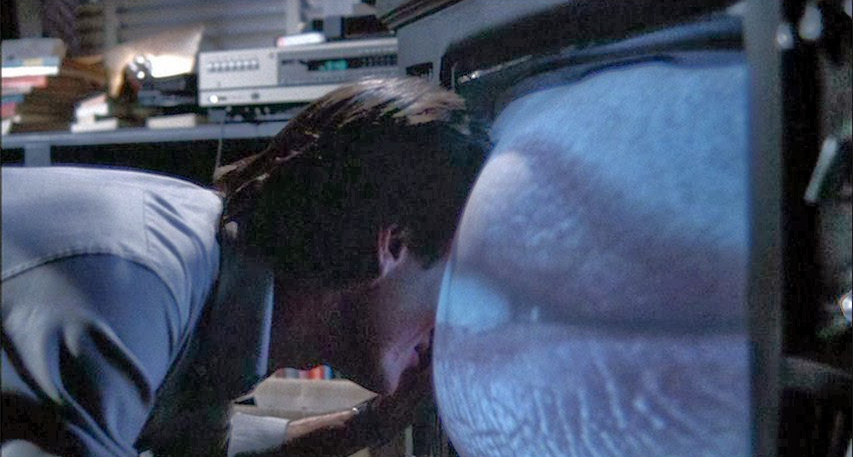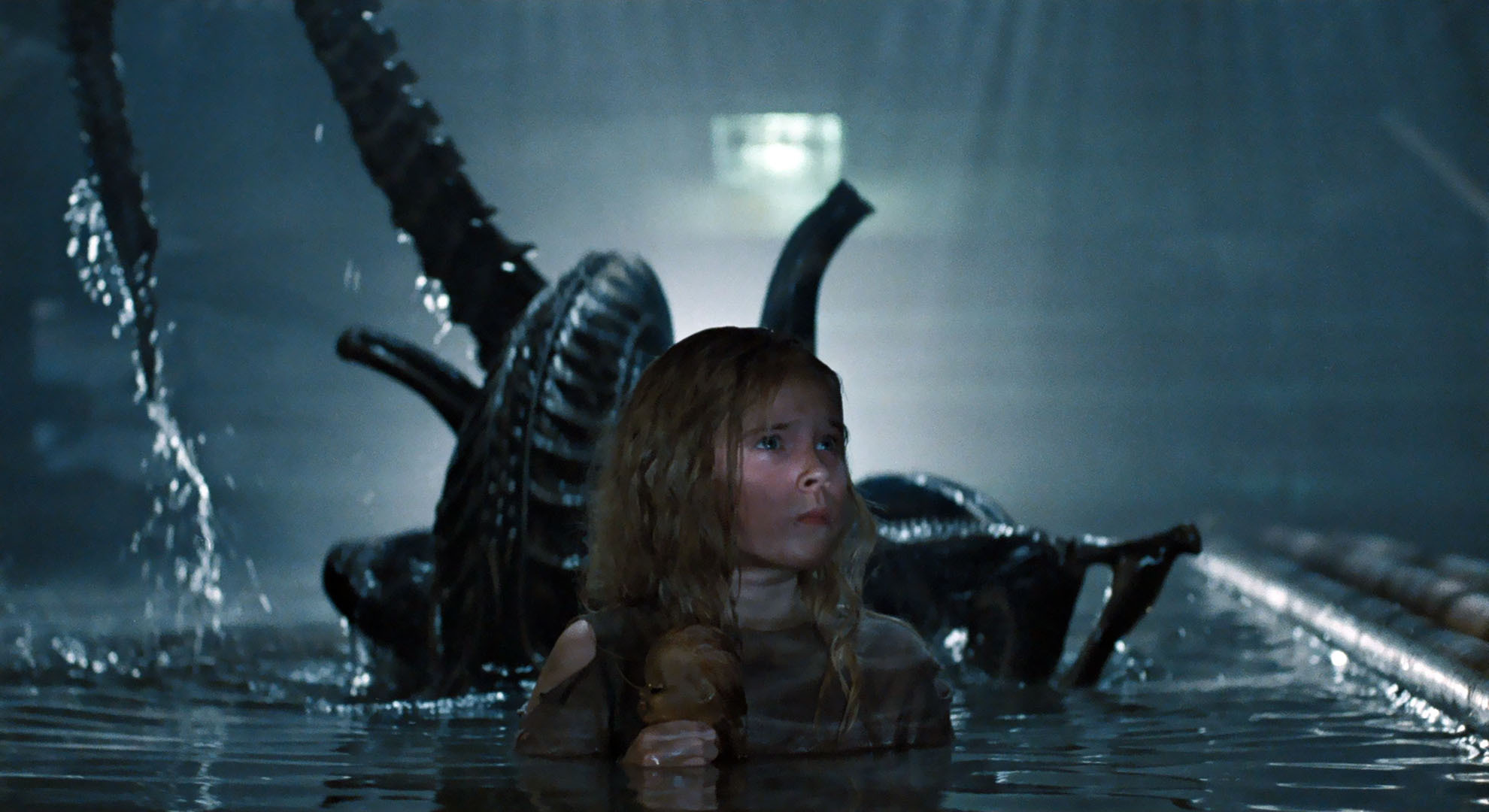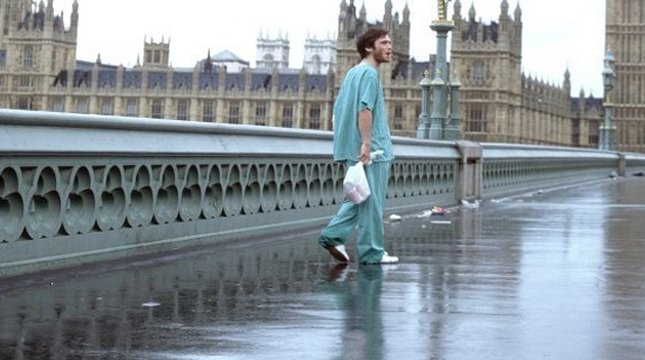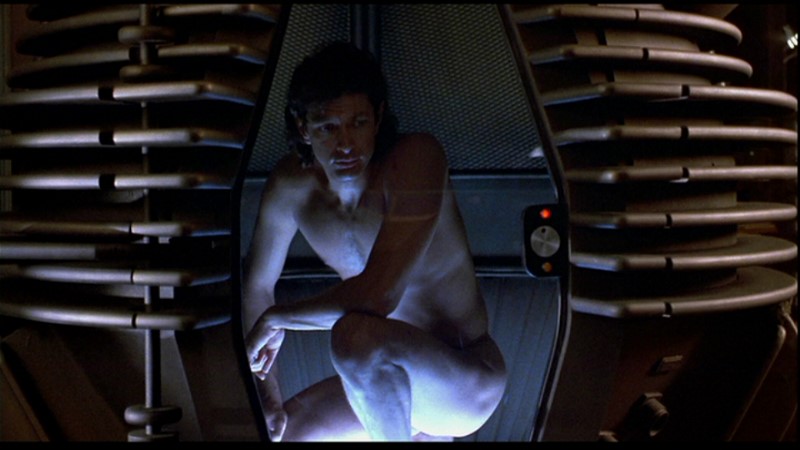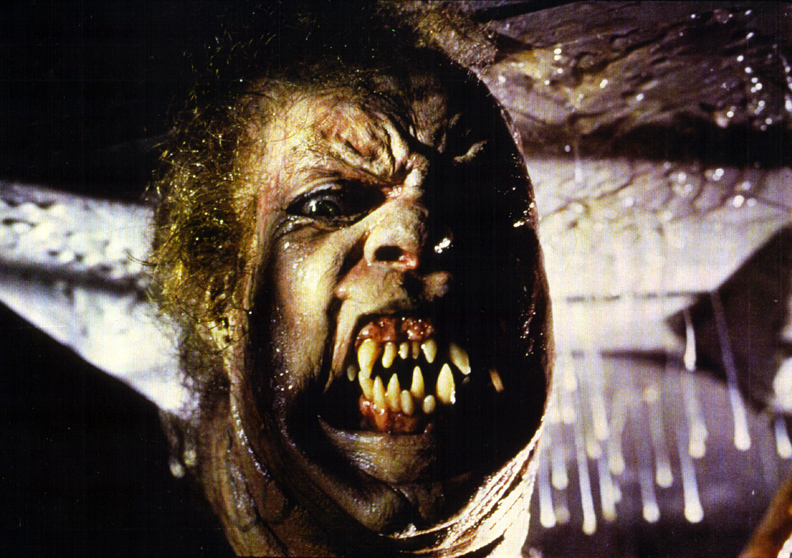8. Videodrome (David Cronenberg, 1983)
Yet another Cronenberg film, and this is probably one of his strangest, in a good way. James Woods plays an incredibly sleazy cable-TV programmer, who begins to see his life and the future of media spin out of control in a very unusual way when he discovers, and subsequently acquires, a new kind of programming for his station, which involves violent imagery.
The first thing to say regarding Videodrome is that it features James Woods at his sleazy best. He’s totally in his element as the amoral TV mogul. Cronenberg knew what he was doing in casting Woods in the lead role. Despite the unpleasant nature of the character portrayed by Woods, he is able to make you like him to a certain extent, which is no mean feat.
Moreover, this film has more bizarre and gruesome practical special effects than you can shake a stick at. One scene in the film involves James Woods reaching into his own stomach and producing a gun, which in turn mutates with his hand. This scene is at the same time both repulsive and utterly fascinating to watch, which is what Cronenberg is able to do so brilliantly. He has an uncanny and unique ability to imagine and create scenes that no one else could ever think of.
The stand-out scene has to be when Woods becomes so obsessed with his new television program that he physically puts his head through his television screen, which then engulfs his whole head, creating a nightmarish piece of imagery, one which they used for the poster of the film.
Cronenberg has a lot to say about our current television and celebrity obsessed culture, and Videodrome is evidence of this. Both terrifying and thought-provoking, Videodrome is one of his greatest works, and thoroughly deserves its place on this list.
7. Aliens (James Cameron, 1986)
“Game over man!” Pvt. Hudson’s (Bill Paxton) famous line from James Cameron’s action packed sequel to Ridley Scott’s Alien, sums up the tone of this film nicely. Cameron took the Alien franchise into new territory, he moved it away from the gripping sci-fi horror genre, towards a more action orientated environment, yet he managed to keep some DNA from the original film.
In this sequel, LV-426, the planet where the Nostromo encountered those nightmare inducing Alien eggs, is now home to a human terraforming colony, Hadley’s Hope (what a fantastic idea). When contact is mysteriously lost from the planet, Weyland-Yutani ask recently discovered Ripley (Sigourney Weaver) to accompany them to investigate what really happened. Not only does Ripley have to deal with encountering a whole army of disgusting and deadly aliens, but she’s also spent the last 57 years of her life drifting through space in stasis, and she hasn’t aged a day. Lucky.
What Aliens lacks in horror, it makes up for in incredible action and spectacle. James Cameron is certainly a master of the action genre, yet that’s not to say that it is no longer a sci-fi horror film. The aliens are still terrifying, and having more of them is certainly a good thing. He also incorporates an utterly vile and humungous mother Alien.
There are one too many ‘look at my machinery’ moments, yet it’s what Cameron does best, and he’s actually directed a sequel that compliments the original nicely, as well as taking it in a new and interesting direction.
Aliens also has one of the best performances in an Alien film, no, not Bill Paxton’s annoying soldier, Lance Henriksen’s depiction of Bishop the cyborg is probably one of the best, and most human renditions of a cyborg ever seen onscreen. It even gives Ian Holm’s Ash and Michael Fassbender’s David a run for their money.
6. 28 Days Later (Danny Boyle, 2002)
Danny Boyle is well known for his fascinating directing style and captivating subject matter. From Shallow Grave to 127 Hours, he can basically direct anything in any genre, and is still able to give the film his unique spin. 28 Days Later is no different. He fundamentally changed the zombie genre for ever, he made zombies terrifying again.
28 Days Later takes place four weeks after (hence the title) a mysterious, incurable virus spreads throughout the UK, due to some slightly overzealous animal rights activists attempting to free a number of virus carrying chimps. Jim (Cillian Murphy) wakes up from a coma in an abandoned hospital and seemingly deserted London with no recollection of what has happened to everybody. Jim has find a way to survive in this post-apocalyptic and dangerous world, inhabited by deadly zombies and in some cases, even deadlier humans.
What makes 28 Days Later such an important zombie movie is that it is very much grounded in reality, or at least it feels as if it is. Along with writer Alex Garland, Boyle managed to create a world which is incredibly believable. You can’t help but picture yourself in Jim’s shoes because everything looks and feels so familiar.
The zombies themselves also feel more threatening than in any previous films involving the undead. Boyle and Garland have given their zombies some nifty new abilities such as the ability to sprint; no more limping hoards of the undead slowly making their way towards a trapped group of young heroes.
The human characters are also just as deadly as the undead. Characters such as Christopher Eccleston’s Major Henry West pose probably the most immediate threat to our band of survivors, which all culminates in a perfect final sequence (watch the film to understand why).
With fantastically directed set pieces, most notably the eery scenes filmed in deserted London streets, and a perfectly crafted script, with new ideas which have changed zombie films for ever, 28 Days Later will always be a must-watch sci-fi horror picture.
5. Under the Skin (Jonathan Glazer, 2013)
Jonathan Glazer is well-known for his usual arthouse brand of direction, yet Under the Skin is probably one of his most out-there films to date. Certainly if you take its casting into consideration, casting the unearthly beautiful Scarlett Johansson was a risk which paid off magnificently. Together, Glazer and Johansson have created something truly different and incredibly absorbing.
There isn’t really much in the way of a plot. The film starts with a beautiful visual of a small bright dot in the centre of the screen, slowly growing, which brings to mind some of the scenes in Kubrick’s masterful 2001: A Space Odyssey. This bright light eventually becomes a light reflecting off of a motorcyclist’s helmet, who is dragging a female body into a white truck.
Scarlett Johansson’s character, in all her nakedness, starts to strip this individual and dresses herself in her clothes. The film then goes on to follow Scarlett’s journey in this white van through the streets of Glasgow and Scottish countryside, where she is hunting for men, attempting to lure them into her van, and ultimately into a rather unusual death.
Nothing much is explained, and there is very little dialogue, which just adds to the strange atmosphere of the piece. Scarlett Johansson is the perfect embodiment of this alien creature, from the way she looks at people, to the way she walks. Everything about her just seems to be slightly off, which is perfect for the role. It was an incredibly brave decision for her to take on this role, due to her star status, yet it was well worth the risk because she is able to demonstrate what a talented actor she is.
Glazer’s direction is also something special. His films always tend to be on the obscure side of cinema, yet his latest picture is his most obscure and opaque film to date. It’s one that all fans of cinema and sci-fi horror should see, due to its strange and eerie quality, accentuated by Johansson’s otherworldly performance, the spine tingling score and captivating visuals.
4. Invasion of the Body Snatchers (Philip Kaufman, 1978)
This is the first in a series of remakes on our list. Philip Kaufman’s 1978 sci-fi horror classic is a remake of Don Siegel’s 1956 film of the same name, which were both inspired by Jack Finney’s novel The Body Snatchers.
Invasion of the Body Snatchers takes place in San Fransisco, where Elizabeth Driscoll (Brooke Adams) starts to notice some strange changes in her boyfriend’s behaviour. She asks her friend and work colleague Matthew Bennell (Donald Sutherland) to help her uncover the truth. Together they discover that the human race is being replaced by alien clones devoid of all emotion.
Kaufman’s film is a rare case where the remake is actually a lot more gripping than the original, mainly due to the fact that it Kaufman doesn’t rely so heavily upon the original source material and was able to create something fascinating and fresh.
It also has a far superior cast than the original film, Donald Sutherland, Brooke Adams, Jeff Goldblum, Veronica Cartwright and Spock himself Leonard Nimoy are all on fine form in this picture. Advancements in practical special effects also helped create a more visually impressive movie.
Where Kaufman really excels is in his ability to create an unavoidable feeling of paranoia. No one can be trusted in this film. He really plays with the traumatising idea of one day waking up next to an imposter, someone posing to be the person you have loved, or been with for years. Add aliens into the mix and you have a pretty scary film.
It will leave you feeling thoroughly creeped out, and making sure that you aren’t surrounded by ‘pod people’ (a slang expression that arose in late 20th Century American culture referencing the emotionless alien duplicates seen in the film). The blood curdling screams these clones make will also give you goose bumps.
3. The Fly (David Cronenberg, 1987)
David Cronenberg’s The Fly is yet another remake to make our list, and this remake is definitely something very special. It has fast become one of David Cronenberg’s most iconic films, and well-known films, with its skin-crawling practical visual effects and first rate performances, most notably from the fly himself Jeff Goldblum.
Seth Brundle (Jeff Goldblum), a brilliant yet eccentric scientist finally manages to uncover the secret to teleporting living things. Before meeting journalist Veronica Quaife (Geena Davis), he was only able to teleport inanimate objects successfully with his ‘telepods’, yet after their first sexual encounter, Seth was finally provided with some inspiration. However, after successfully teleporting a live baboon, jealousy and alcohol lead him to attempt the first human trial, upon himself. However, things don’t quite end up the way he had planned, and Seth starts to undergo a disturbing and ultimately terrifying transformation.
The Fly was written and directed by Cronenberg, loosely based on George Langelaan’s 1957 short story of the same name, which also served as inspiration for Kurt Neumann’s original 1958 film. However, Cronenberg adapted the source material and original film to incorporate some more ‘Cronenbergian’ themes. He was able to highlight the horror of Seth’s awful metamorphosis, and yet also capture his humanity. During Seth’s transformation he slowly loses his humanity and becomes more fly than human, yet Cronenberg accentuates the more human aspects of the story: lust, love, jealousy, loss and ultimately selflessness.
The film wouldn’t have been so terrifying if it hadn’t been for Cronenberg’s ability to make you relate to Seth’s horrific transformation. Yes, there are many scenes of body horror which are pretty difficult to watch, yet it’s the loss of Seth’s humanity, and his battle with his transformation which will stay with you long after the film has finished.
Only a filmmaker as talented as Cronenberg could have pulled off this feat. Add to this Goldblum’s sensational performance and you have the makings of a true masterpiece, and one which all fans of sci-fi horror should watch. Everybody should witness Cronenberg’s The Fly, it’s a very important film for cinema as a whole.
2. The Thing (John Carpenter, 1982)
As you can probably tell by now, sci-fi horror is far more than just special effects and a bit of gore. It’s more about ideas, and how they are developed onscreen. John Carpenter’s remake of Christian Nyby and Howard Hawks’s The Thing from Another World, which was based upon John W. Campbell Jr.’s short story “Who Goes There?”, is easily one of the most precisely crafted sci-fi horror films on this list.
John Carpenter’s attention to detail is second to none, every severed limb, every spider-like moving head; everything is so perfectly crafted and beautifully rendered onscreen. It highlights the importance of physical practical effects. So much is lost on us now that we are in the age of relentless CGI, one forgets how mesmerising it is to watch the physical contraptions people have spent painstaking hours over, come to life onscreen.
The plot is quite straightforward, and all the better for it. A team of American scientists, posted in the Antarctic, come into contact with a deadly shape-shifting alien which can take on the appearance of the people that it kills. R.J. MacReady (Kurt Russell) and his colleagues have to go to extreme lengths to find an alien hiding in plain sight.
Kurt Russell, who has worked with Carpenter on many occasions, is once again incredibly cool, as the resourceful R.J. MacReady. To be honest, it’s hard for Kurt Russell not to be undeniably cool. He is backed up by a fantastic supporting cast, including, but not limited to the silver voiced Keith David.
However, it’s in John Carpenter’s direction and his ability to create wonderfully chilling and suspenseful horror films where The Thing really excels. If it wasn’t for him, it might have just been another ordinary alien film, which the terribly ordinary 2011 remake went a long way to prove.
John Carpenter was able to bring everything together: the stunning and ingenious practical special effects, Kurt Russell’s charisma, and the wonderfully frighting source material, to make one of the very best and well-respected sci-fi horror films of all time.
1. Alien (Ridley Scott, 1979)
“In space no one can hear you scream!” If that tag line doesn’t send shivers down your spine then nothing will. Ridley Scott’s 1979 masterpiece is easily one of the most memorable, terrifying and game-changing sci-fi horror films ever made.
Alien follows the torrid tale of the crew on board the commercial space vessel the Nostromo. Whilst on a return trip to Earth the crew are woken up from stasis due to a distress call from an unexplored and apparently deserted planet. After searching the planet for survivors, they happen upon a spaceship full of menacing looking eggs.
When one of those eggs opens and whatever was inside attacked Kain (John Hurt) the rest of the search party rush him back to their ship and attempt to pry the alien ‘face hugger’ off of the poor man’s face. Soon they realise that they are not alone and that a deadly alien creature has hitched a lift.
Alien is not only a fantastic film, it’s also an incredibly iconic and important one. Everything from the celebrated chest-buster scene, all the way to the Alien itself, is iconic. Ridley Scott’s film inspired a whole generation of filmmakers, as well as spawning a film franchise, which is still alive to this day. H. R. Giger’s designs behind the alien creature itself, as well as the famous disk jockey, are beautifully strange and horrific at the same time. No one has ever really managed to design an alien life form quite as impressive as his since.
It was also one of the very first Hollywood action orientated films to put the female character first. Sigourney Weaver’s Ellen Ripley is not your damsel in distress, she is a resourceful, clever and brave woman, who takes on this hideous alien basically by herself. As the franchise continued she became almost as dangerous as the aliens themselves.
The look of the film was also something entirely new. It was the first time we saw space gunk on spaceships; the Nostromo is an old, used, retro-futuristic and grimy ship, which it probably would be if it spends years travelling through space. It is almost redolent of a big oily old cargo ship sailing across the oceans of Earth.
Before Alien all the spaceships we saw onscreen were clean, mostly white and rather plastic looking (2001: A Space Odyssey, Star Trek, Star Wars). Nowadays most films set in space have taken a leaf from Alien’s book, incorporating dirty and old spaceships. It helps create an ominous atmosphere, which lends itself well to the sci-fi horror genre.
Author Bio: Edward James Lauder is a graduate from Royal Holloway University in London and currently an MA Multimedia Journalism student at Westminster University, he strives to help people chose which films to see or not to see. He was subjected to studying French cinema at university and subsequently fell in love with everything to do with the craft.
